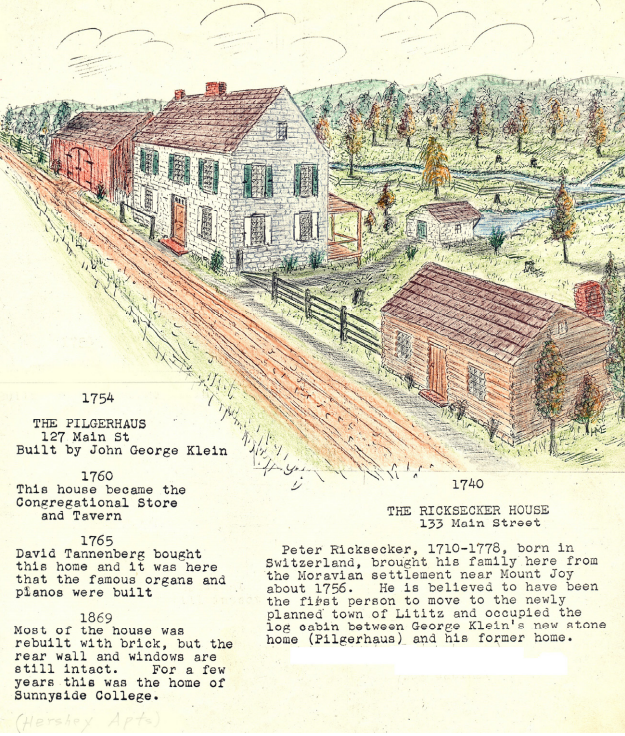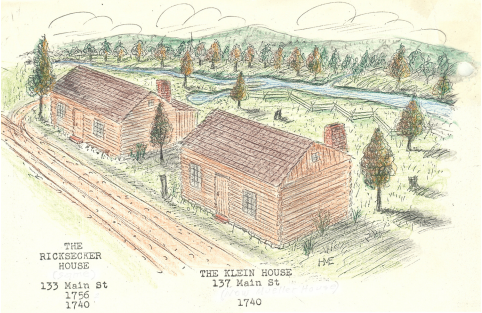

The Pilgerhaus 127 Main Street Built 1754 by John George Klein
Bro. George Nixdorf, of Lancaster, was the first occupant. It was in this building that the first settlers of Zinzendorf’s Congregation village, three families from Donegal and four from Bethel, found refuge when they fled to escape Indian raids. A portion of the wall of this first house was left standing when the building was removed in 1866, and now forms part of the rear wall of the present three-story brick building which stands on its site at 125 East Main Street.
In 1754 a Provincial Synod was held in the stone house in order to select the man who would be charged with the organization and guidance of the new Moravian settlement as well as supervising the country congregations. Bishop Hehl was appointed by lot and took up residence in Klein’s stone house. Thereafter it was called the PilgerHaus.
In 1760 the Moravian Congregational Store and Tavern was located here until its relocation in 1764 across the street. The first hotel in Lititz was also in the PilgerHaus. Started in 1762 by the Moravians it was called “The Zum Anker” or “Sign of the Anchor.” It relocated in 1764 to Broad and Main Streets and today is known as the General Sutter Inn.
David Tannenberg bought this home in 1765 and it was behind this house in his shop that the famous organs and pianos were built. Tannenberg died in York in 1804 when he fell to his death from scaffolding. He was installing an organ in the Lutheran Church in York.
From 1862 to 1878, it was a school for girls. In 1855, Rev. Julius Theodore Beckler was principal of Linden Hall. In 1862, during the Civil War, the enrollment at the school diminished and Beckler was dismissed. After his dismissal, he started Sunnyside College for Girls. The school was greatly objected to by the Provincial Elders Conference, because of its possible injury to Linden Hall. In order to afford better accommodations for the young ladies, the present commodious edifice was erected in 1867 five years after the school opened. He replaced the twostory stone PilgerHaus with the current three-story brick building (except for the rear stone wall). A third floor was added. In the back, you can still see the first and second floor made of stone, while the third is made of brick. On the second floor, a door led to an extensive balcony overlooking the main street, accessible to the young ladies at all times during the hours of recess.
J. W. G. Hershey added the two wings to the back of the building. He kept horses in a barn where the garages are now located. That was the area where the spring was located. Old Lititz maps show a small stream running from the spring to Lititz Run.
During World War II, the basement was designated an Air Raid Shelter. Abe Hershey was Chief Air Warden and supplies were stored in the basement. Abe Hershey purchased the building from his mother’s estate in 1952.
The Ricksecker House 133 Main St.
Peter Ricksecker, 1710-1778, was born in Switzerland. He brought his family from Donegal to Lititz about 1756. Klein had just completed his stone house. It was the “Pilger House.” Two log houses are referred to in early records and the two old cellars at 133 and 137 Main Street support the belief that these were the first homes of George Klein and later Peter Ricksecker. (There is no record of when the house was rebuilt.) John Ricksecker, 1749-1813, son of Peter and a shoemaker, lived here. John married Rachael Frederick and has ten children. John Ricksecker, 1789-1871, son of John, married Louisa Fisher. He spent the latter part of his life with his son in Mt. Joy.
The Ricksecker House 1740 133 Main Street
Peter Ricksecker, 1710-1778, born in Switzerland, brought his family here from the Moravian settlement near Mount Joy about 1756. He is believed to have been the first person to move to the newly planned town of Lititz and occupied the log cabin between George Klein’s new stone home (PilgerHaus) and his former home.
The Klein House (Now the Mueller House) 1740 137 Main St.
This is one of the first structures in Lititz and was occupied by John George Klein and his wife when they arrived here in 1740. In 1754 he built a two-story stone house (Pilgerhaus) “near his log house.” “In 1755 Henry Haller arrived to take charge of the farm. He took up his quarters in Klein’s Log House ‘at the spring’. In 1760 Haller moved into the new farm-house across the creek, and the house ‘at the spring’ vacated by him was occupied by Dr. Frederick Otto.” (These quotes from Brickenstein.) There is little doubt that this was the site of George Klein’s first home. It was rebuilt in 1794 by Johannes Mueller.
